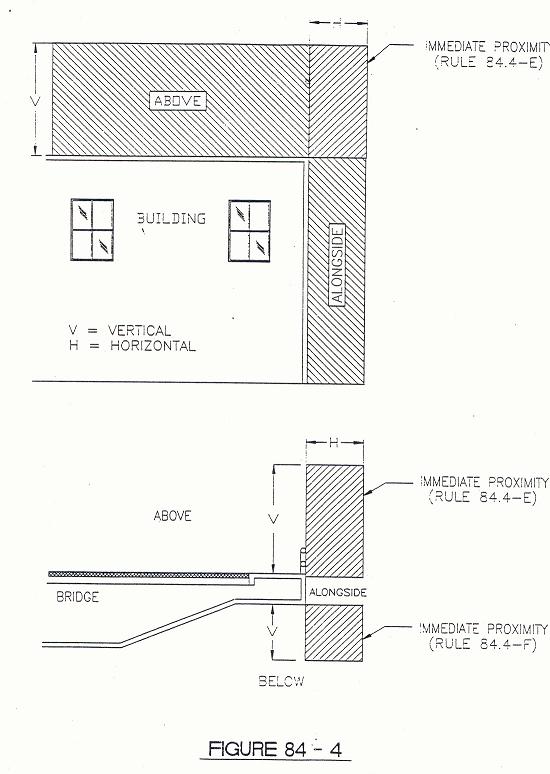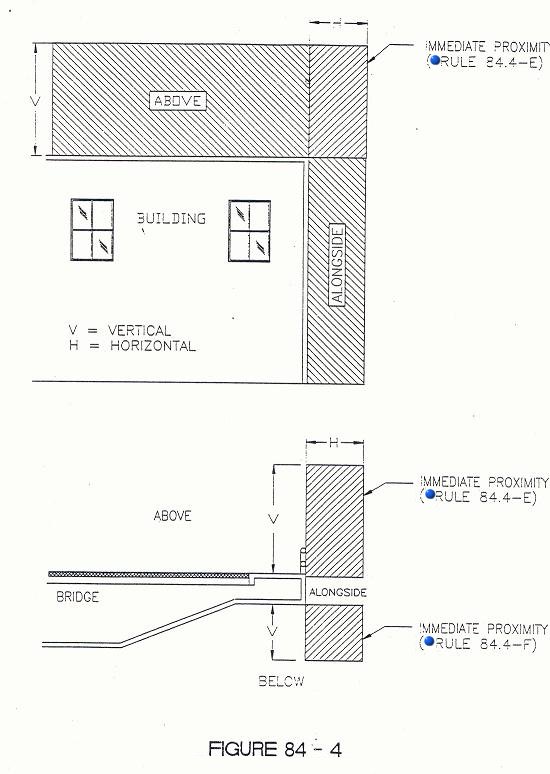
Original Version
Rule 84.4-E
84.4-E. Above Alongside Or In Immediate Proximity To Building, Bridges And Other Structures.
Conductors should be arranged so as not to hamper or endanger firefighters and workers in performing their duties. The basic clearances of communication conductors from buildings are specified in Table 1, Cases 6 and 7, Column B. The horizontal clearance (Table 1, Case 7) shall be maintained until the vertical clearance (Table 1, Case 6) is attained ( see Figure 84-4). The requirements of Table 1, Case 7, Column B also apply at fire escapes, windows, doors, and other points at which entrance or exist might be reasonably expected.
Communication cables are not required to be any specified instance from the other sides of buildings, bridges and other similar structures, but they shall be installed so that they do not interfere with the free use of fire escapes, windows, doors and other points at which entrance or exit might be reasonably expected.
The vertical clearance of communication conductors (including cables) above buildings specified in Table 1, Case 6, Column B may be reduced to not less than 2 feet under either of the following conditions;
(1) Over roofs of 3/8 pitch (37 degrees from the horizontal) or greater, or
(2) Over roofs where the conductor does not overhang the building by more than 6 feet.
See Rule 84.8-C4 for service drop clearance requirements.

Strikeout and Underline Version
Rule 84.4-E
84.4-E. Above Alongside Or In Immediate Proximity To Building, Bridges And Other Structures.
Conductors should be arranged so as not to hamper or endanger firefighters and workers in performing their duties. The basic clearances of communication conductors from buildings are specified in Table 1, Cases 6 and 7, Column B. The horizontal clearance (Table 1, Case 7) shall be maintained until the vertical clearance (Table 1, Case 6) is attained ( see Figure 84-4). The requirements of Table 1, Case 7, Column B also apply at fire escapes, windows, doors, and other points at which entrance or exist might be reasonably expected.
Communication
cables are not required to be any specified instance from the other
sides of buildings, bridges and other similar structures, but they shall
be installed so that they do not interfere with the free use of fire escapes,
windows, doors and other points at which entrance or exit might be reasonably
expected.
The vertical clearance of communication conductors (including cables) above buildings specified in Table 1, Case 6, Column B may be reduced to not less than 2 feet under either of the following conditions;
(1)
Over
roofs whose slope exceeds 9 inches of rise per 12 inches of
run (see Sketch), of 3/8 pitch (37 degrees from
the horizontal) or greater, or

(2) Over roofs where the conductor does not overhang the building by more than 6 feet.
See Rule 84.8-C4 for service drop clearance requirements.

Final Version
Rule 84.4-E
84.4-E. Above Alongside Or In Immediate Proximity To Building, Bridges And Other Structures.
Conductors should be arranged so as not to hamper or endanger firefighters and workers in performing their duties. The basic clearances of communication conductors from buildings are specified in Table 1, Cases 6 and 7, Column B. The horizontal clearance (Table 1, Case 7) shall be maintained until the vertical clearance (Table 1, Case 6) is attained ( see Figure 84-4). The requirements of Table 1, Case 7, Column B also apply at fire escapes, windows, doors, and other points at which entrance or exist might be reasonably expected.
Communication cables are not required to be any specified instance from the sides of buildings, bridges and other structures, but they shall be installed so that they do not interfere with the free use of fire escapes, windows, doors and other points at which entrance or exit might be reasonably expected.
The vertical clearance of communication conductors (including cables) above buildings specified in Table 1, Case 6, Column B may be reduced to not less than 2 feet under either of the following conditions;
(1) Over roofs whose slope exceeds 9 inches of rise per 12 inches of run (see Sketch), or

(2) Over roofs where the conductor does not overhang the building by more than 6 feet.
See Rule 84.8-C4 for service drop clearance requirements
